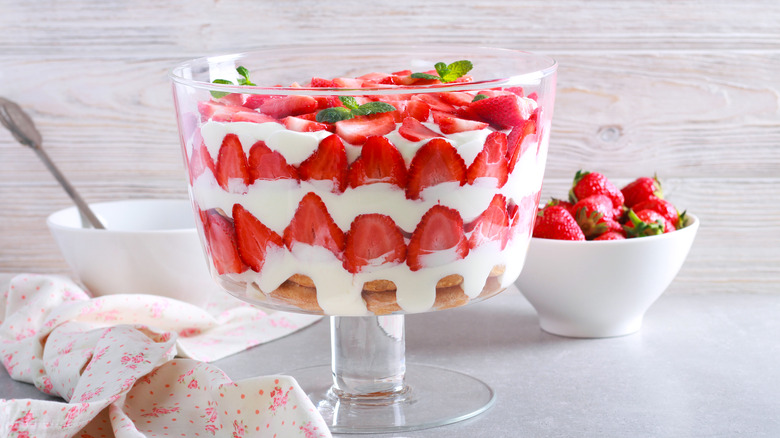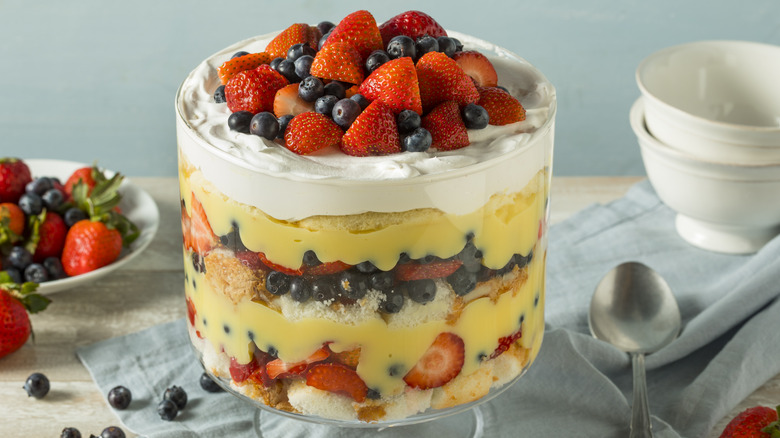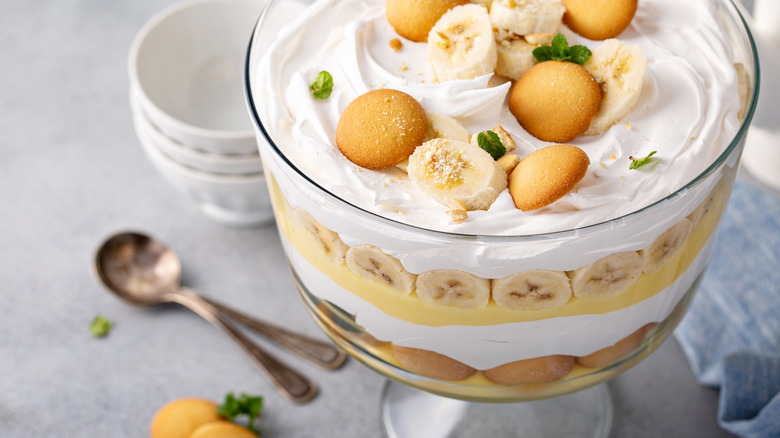How Modern Trifles Differ From The Original Recipe
Few desserts look as stately and elegant as a perfectly assembled trifle. Colorful layers of cake, custard, and fruit are stacked in a footed glass or crystal bowl with tall sides, as to show off the treat from all angles. They are especially popular in the American South where they are often served on holidays, but like many foods in the U.S., the trifle has international roots. The people of Britain consider the dessert an important tradition, as it has been gracing their tables for hundreds of years.
Naturally, it has evolved over time and, while modern versions are similar to the original, they usually are not identical to it. As new ingredients and recipes have entered modern times, recipes have changed. Like so many recipes in all cultures around the globe, the trifle may have come from the mentality of never wasting a scrap of food or turning leftovers into an entirely separate meal. If that dish happens to turn into something sweet, all the better.
The history of the trifle and the original recipe
English trifles first appeared in Britain in the 18th century as a way to use up leftovers, stale cake which was soaked in alcohol (often sherry) and layered with custard. It is unclear which desserts appeared first, but the English trifle bears a striking resemblance to Italian Zuppa Inglese and Spanish Bizcocho Borracho. Zuppa Inglese is a layered dessert that consists of sponge cake or ladyfingers soaked in a liqueur called Alchermes, plus pastry cream, and chocolate cream. Bizcocho Borracho is made by soaking ladyfingers in espresso and brandy or rum and layering them with custard and chocolate.
In the late 1700s, literate Americans were, for the most part, relying on cookbooks from England to discover new recipes and, thus, unearthed the trifle. Either that or it was picked up from incoming Brits coming from across the pond. Either way, these early recipes mention the addition of jelly as an ingredient which is the equivalent of American Jell-O.
Later, in 1796, an American cookbook by Amelia Simmons mentions a traditional trifle made with broken biscuits (cookies), cake, wine, and boiled custard with the addition of syllabub (an old confection made from whipped cream and lemon juice) and flowers for decoration. The trifle appealed to the belles of the American South who thought the ornate dishes that trifle was served in fit in perfectly with their love of elaborate decoration, thus, beginning the Southern trifle tradition.
How trifles are made today
Somewhere along the way, fruit began making an appearance in trifles, and the practice clearly stuck because most trifle recipes today include some sort of fresh or frozen fruit. Modern trifles still tend to utilize a sturdy type of cake, like sponge cake or pound cake, but it's usually baked fresh or store-bought, not stale or old like its predecessors. Trifle flavors can vary widely and they are very easy to assemble on the fly.
Some people use cake slices, while others cut it into cubes or simply tear the cake into chunks. Measurements aren't as important as how even the layers look on the outside of the dish. If the end result looks symmetrical and colorful, and the custard isn't too thick or thin, it's basically a success. Many trifles today even use boxed pudding instead of homemade boiled custard and since trifles appeal to both adults and children, the alcohol is often left out altogether.
Strawberries, bananas, blueberries, peaches, and raspberries are popular fruits for trifles, but not all trifles are fruity. Some recipes swap cake for brownies which might be used to create the base for a chocolate trifle that includes pieces of candy bars. Pumpkin cheesecake, caramel apple, tres leches, if you can come up with a flavor combination, you can probably make a trifle out of it. Although not completely true to the original trifle origin, they are fun desserts that are easy to make and even easier to enjoy.


